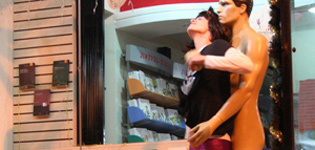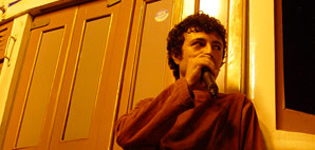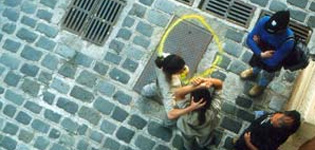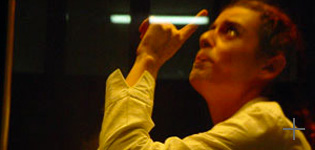Obra
DESNONISSEA estreia no dia 23/09/21 e fica em cartaz até janeiro de 2022 no Arts Santa Mónica em Barcelona. O texto a seguir descreve esse processo de criação em colaboração entre ERRO Grupo e Roger Bernat.
DESNONISSEA
(English Below)
Muito felizes em poder anunciar esta obra que estreia dia 23/09/21 e ficará em cartaz até janeiro de 2022 no Arts Santa Mónica em Barcelona!
Em 2020, quando estávamos em processo de criação de no hay citas disponibles. encontramos em uma revista de bairro, a Revista Masala, uma reportagem sobre os despejos que ocorrem diariamente em Barcelona. A última cena de no hay citas disponibles. surgiu deste artigo, “Anatomia de un Desahucio”, publicado na Masala em junho de 2020. Quando o lemos fizemos uma piada imaginando que eram as instruções para realizar uma obra de Roger Bernat. A cartografia descrita pela equipe Masala, com ilustrações de @biksakura, nos convida a brincar – ou pelo menos observar um despejo – com um olhar mais treinado, ou melhor, nos treina a participar desta situação de uma forma muito particular, instigante e pedagógica. Poucos meses depois, a piada se revelou cheia de verdade, como todas as piadas: Bernat, após participar de no hay citas disponibles., nos propõe a dar continuidade a essa cena final para a exposição no Arts Santa Mónica, em Barcelona, como um teatro de spin off, ou de bonus track.
O texto abaixo, de Luana Raiter e Pedro Bennaton, é um curto artigo sobre esse processo de criação em colaboração entre ERRO Grupo e Roger Bernat:
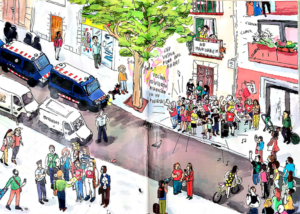 Il·lustració: @biksakura, Revista Masala núm. 80, juny 2020.
Il·lustració: @biksakura, Revista Masala núm. 80, juny 2020.
UN DÉTOURNEMENT PARA EL DESNONAMENT DE LA DESNONISSEA
De Pedro Bennaton y Luana Raiter (ERRO Grupo)
La cuestión que suena desde mayo de 2021, ¿cómo representar un desahucio?, es el gran problema y desafío de la Desnonissea (Roger Bernat y ERRO Grupo). Spin off de la escena final (o bonus track) de no hay citas disponibles. (ERRO, 2020), una pieza que, como dijo Manuel Delgado, funcionaba como una película sueca: aunque tuviera un final esperado y deseado, acababa en suspensión. Ahora la escena final gana vida propia por el impulso de un Dungeon Master del teatro contemporáneo. Un director que, con decenas de dispositivos sencillos y ultra complejos a la vez, consigue poner al público a hacer teatro.
En una de las presentaciones de no hay citas disponibles., una persona que pasaba por la calle durante la última escena solicitó un rol en el desahucio que se estaba a punto de representar. Esa persona fue designada para hacer de abogado de la inquilina. Los otros participantes, que habían visto el espectáculo completo y entendido que no había nada que representar porque el espectáculo había acabado, dejaron al espontáneo espectador sin poder representar su rol. Frustrado, vino a pedirnos explicaciones por la ese abrupto final precisamente en el momento en el que él había llegado, quejándose de no poder representar el papel que le había sido asignado. Lo mismo pensó Roger Bernat, que estaba en el estreno de la obra y que nos sugirió llevar la última escena más allá y crear una “constelación familiar” del desahucio. Pero ERRO había resuelto ya representar la tragedia suspendiéndola y dando fin al espectáculo. Entregar los diferentes roles que participan de un desahucio y, en ese preciso momento, abandonar al público a su destino. Dado que la pieza trataba de inmigración y burocracia, el desahucio no podía ser más que un bonus track o anuncio de un nuevo capítulo del drama representado.
Esa última escena de no hay citas disponibles. surge del artículo “Anatomía de un Desahucio”, publicado en la revista Masala en Junio del 2020. Al leerlo, bromeamos imaginando que se trataba de las instrucciones para realizar una obra de Roger Bernat. La cartografía descrita por el equipo de Masala, con ilustraciones de @biksakura, invita a jugar –o al menos a observar el desahucio– con una mirada más entrenada, o mejor, nos entrena a participar de la situación con una pedagogía muy particular e incitativa. Unos meses más tarde, la broma reveló estar llena de verdad, como todas las bromas. Bernat nos propone dar continuidad a la escena para la exposición en el Arts Santa Mónica. Uno de las mejores cosas que le ha ocurrido a ERRO es que alguien se tomara en serio una provocación e intentara concretarla en una nueva obra. Bernat nos desafía y se desafía a pensar en cómo representar un desahucio. En primer lugar nos propone una investigación etnográfica con las personas que tienen funciones importantes en los desahucios y más tarde inicia junto con Núria Martínez-Vernis y Oriol Sauleda la redacción de un poema dramático que conduzca a los participantes en el camino de representar la tragedia.
Los teatros tienen vacaciones, los museos también, pero el desahucio nunca se acaba en esta ciudad. Como el espectáculo del drama social, el desahucio es constante. Es el espectáculo más repetido que uno puede experimentar aquí. Incluso en ciudades de las afueras, como Vilafranca, l’Hospitalet o Sant Celoni, hay desahucios todos los días. El desahucio es un drama que no acaba. Una performance en sesión continua que se traslada de una calle a otra, de un piso a otro, de una persona sin casa a otra. Cada nuevo desahucio se conecta con el próximo y viene del anterior. Los desahucios involucran a la ciudad entera. Imaginamos que un desahucio se acaba cuando una vecina es lanzada a la calle, o cuando un vecino se suicida, o cuando la peña consigue pararlo. Pero un desahucio es lo que vivimos cada día en la ciudad. Un desahucio continuado que atraviesa todos los desahucios.
Arts Santa Mónica es un museo, no un teatro (aunque hoy en día los teatros cada vez se parecen más a museos y los museos a teatros). En este museo ubicado en La Rambla, justo delante a las estatuas humanas y de los monumentos al teatro y Colón, se plantea la posibilidad de representar un desahucio, y para ello dar las herramientas al público para convertirse en actores y actrices de este homérico viaje. Para ello se invita al público a encarnar las estatuas y, con sencillas poses, evocar el potencial dramatúrgico de la quietud. Trasladar al interior del museo la poética de las estatuas que hay a las puertas del museo y mostrar en el cuerpo de los visitantes las huellas de un drama, el del desahucio, que es una performance que todos llevamos largo tiempo aprendiendo.
¿Pero cómo formar al público? ¿Cómo actualizar lo que el visitante ya sabe para convertirlo en un drama estatuario, un drama de estatuas vivas? Rebeca Schneider nos recuerda en Performance Remains (2001) que las estatuas son la performance de más larga duración. Los monumentos a Colón en las plazas públicas de las ciudades españolas y latinoamericanas eternizan la performance de la colonización. La humanidad está hecha de un desplazamiento constante a partir de la invasión de quien tiene más poder en los espacios de quien tiene menos.
La estatua es la continuación de la performance del hecho histórico que permanece en el presente. Una performance eterna que actúa en nuestra vida cotidiana. El cartel de “piso disponible” es un desahucio que está ocurriendo, aunque parezca que ya haya acabado. Lo que plantea Schneider no es solamente que las estatuas continúan las performances políticas y sociales del pasado, sino que las proyectan hacia el futuro y actúan en el presente. Una estatua muestra un gesto que va más allá del instante representado: enseña también la posición en la que estaba antes y hacia la que se dirige después.
¿Cómo se posicionan las estatuas en la Desnonissea? Augusto Boal, en su Teatro del Oprimido (1973), propone como una de las categorías de su teatro, el Teatro Imagen. Este tipo de teatro social se hace para que las personas transformen en imágenes estáticas las situaciones de opresión a las que están sometidas. A partir de un ritmo muy pausado, los participantes del Teatro Imagen crean imágenes clave de su pasado, presente y futuro.
Hoy en día, incluso un turista sería capaz de mostrar el Teatro Imagen de un desahucio. Las imágenes del desnonament se han convertido en postales tan reconocibles de la ciudad como las que fueron selladas con el logotipo de la Marca Barcelona.
Sin embargo, el Teatro Imagen es una de las categorías menos practicadas del Teatro del Oprimido. El Teatro Fórum, por ejemplo, tiene mucha más difusión, hasta el punto de que el Teatro Imagen es a veces considerado como un calentamiento para el Teatro Fórum. Aunque en las redes sociales practiquemos un cotidiano Teatro Imagen hecho a base de selfies y likes en las selfies de otros, en una perpetua representación estática de nuestra vida cotidiana.
Desnonissea da las herramientas necesarias para dotar de autonomía al visitante del museo para que pueda representar el poema épico, la tragedia contemporánea, la cruel postal de Barcelona que, sin embargo, es un drama que viene de antiguo y se proyecta, como las estatuas, en el futuro. Especialistas en dirección escénica, declamación, mimo y Teatro Imagen, pero también personas que han vivido en primera persona el drama del desahucio, dirigen una acción que, de todos modos, llevamos aprendiendo desde hace siglos. España debe su riqueza al desahucio de la colonización. El sistema capitalista no deja de ser un mecanismo que funciona precisamente gracias al desahucio de poblaciones que son exterminadas u obligadas a migrar. Desnonissea es la re-escenificación de este sistema.
(continuará)
DESNONISSEA
EQUIP: Roger Bernat amb la col·laboració d’ERRO Grupo (Luana Raiter i Pedro Bennaton). Poema èpic de Núria Martínez-Vernis i Oriol Sauleda. Testimonis i indicacions de Walter San Joaquín (mim i estàtua viva), entre d’altres. Agraïments: MNAC. Producció: Arts Santa Mònica.
Sinopsis em https://rogerbernat.info/en-gira/desnonissea-2021/:
La Desnonissea és un encàrrec d’Enric Puig, nou director de l’Arts Santa Mònica de Barcelona que es podrà veure entre el 23 de setembre i principis de gener del 2022.
Aquí l’explicació la descripció de la peça a principis d’agost:
1) A l’entrada del claustre del Centre d’Art Santa Mònica hi ha un camerino on el públic és convidat a emblanquinar-se la cara i les mans. En una altra taula, hi ha els llibrets amb el poema dramàtic de la Núria Martínez-Vernis i l’Oriol Sauleda, que s’ha de representar.
2) Al claustre hi ha diferents peanyes que, pel seu tamany, són també escenaris a diferents nivells. A sobre de cadascun d’aquest escenaris hi ha escultures d’inspiració clàssica i de tamany natural que representen: una fera portant entre les dents el cadàver d’un ésser humà, una venus estirada sobre uns coixins, una mare protegint un nadó i un gladiador.
3) Entre les escultures també hi ha televisors on Walter San Joaquín, president de la República de les Estàtues Humanes de La Rambla i d’altres persones expliquen com representar els diferents personatges des dels seus particulars àmbits de saber.
4) A part d’escultures, escenaris i videos, davant de cada escenari hi ha un faristol que indica quins personatges han d’ocupar cada escenari. Així el públic emblanquinat, acompanya les escultures sobre les diferents peanyes i representa el drama com si fossin estàtues humanes.
El públic que ve a representar el drama pot fer-ho després d’haver vist l’exposició, després d’haver-se descarregat el text al web del museu o sense haver-se preparat gens ni mica.
(English)
A DÉTOURNEMENT FOR THE DESNONAMENT OF THE DESNONISSEA.
By Pedro Bennaton and Luana Raiter (ERRO Grupo)
The question that has been ringing since May 2021 “how to represent an eviction?” is the great problem and challenge of the Desnonissea (Roger Bernat and ERRO Grupo). Desnonissea is a spin-off of the final scene (or bonus track) of no hay citas disponibles. (ERRO, 2020), a piece that, as Manuel Delgado said, worked like a Swedish film: although it had an expected and desired ending, it ended in suspension. Now the final scene gains a life of its own by the impulse of a Dungeon Master of contemporary theater. A director who, with dozens of simple and ultra-complex devices at the same time, manages to get the audience to act.
In one of the performances of no hay citas disponibles., a person passing by on the street during the last scene requested a role in the eviction that was about to be staged. That person was designated to play the tenant’s lawyer. The other participants, who had seen the whole performance and understood that there was nothing to play because the show was over, left the spontaneous spectator unable to play his role. Frustrated, he questioned us about this abrupt end precisely at the moment when he had arrived and thought things would start, complaining about not being able to play the role that had been assigned to him. Roger Bernat, who was at the premiere of the play, thought the same thing and suggested that we take the last scene further and create a “family constellation” of the eviction. However, ERRO had already decided to represent the tragedy by suspending it and ending the show. Delivering the different roles involved in an eviction and, at that precise moment, abandoning the audience to their fate. Since the piece was about immigration and bureaucracy, the eviction could only be a bonus track or an announcement of a new chapter of the represented drama.
That last scene of no hay citas… was created from the article “Anatomía de un Desahucio” (Anatomy of an Eviction), published in the Revista Masala in June 2020. When we read it, we jokingly imagined that it was the instructions to perform a Roger Bernat’s play. The cartography described by the Masala team, with illustrations by @biksakura, invites us to play – or at least to observe the eviction – with a more trained eye, or better, it trains us to participate in the situation with a very particular and inciting pedagogy. A few months later, the joke revealed to be full of truth, like all jokes. Roger Bernat proposes us to think further the possibilities of that situation, for the exhibition at the Arts Santa Monica. One of the best things that ever happened to ERRO is that someone took a provocation seriously and tried to turn it into a new work. Bernat challenges us and challenges himself to think about how to represent an eviction. First, he proposes an ethnographic research with the people who have important roles in the evictions and later he initiates with Núria Martínez-Vernis and Oriol Sauleda the writing of a dramatic poem that leads the participants on the way to represent the tragedy.
Theaters close for vacations, museums too, but the eviction never ends in this city. As the spectacle of social drama, the evictions are frequent, constant. It is the most repeated spectacle one can experience here. Even in suburban towns like Vilafranca, l’Hospitalet or Sant Celoni, there are evictions every day. The eviction is a drama that never ends. A performance in looping that moves from one street to another, from one apartment to another, from one homeless person to another. Each new eviction connects with the next and comes from the previous one. Evictions involve the whole city. We imagine that an eviction is over when a neighbor is thrown into the street, or when a neighbor commits suicide, or when people manage to stop it. Nevertheless, an eviction is what we experience every day in the city. A continuous eviction that crosses all evictions.
Arts Santa Monica is a museum, not a theater (although nowadays theaters increasingly resemble museums and museums resemble theaters). In this museum located on La Rambla, just in front of the human statues and the monuments to the theater and Columbus, the possibility of representing an eviction is proposed, and to do so, give the audience the tools to become actors of this Homeric journey. The audience is invited to embody the statues and, with simple poses, evoke the dramaturgical potential of stillness. Transferring the poetics of the statues at the museum’s doors to the interior of the museum and showing on the visitors’ bodies the traces of a drama, that of eviction, which is a performance that we have all been learning for a long time.
However, how to educate the public, how to update what the visitor already knows and turn it into a drama of statues, a drama of living statues? Rebecca Schneider reminds us in Performance Remains (2001) that statues are the longest lasting performance. The monuments to Columbus in the public squares of Spanish and Latin American cities eternalize the performance of colonization. Humanity is made of a constant displacement from the invasion of those who have more power in the spaces of those who have less.
The statue is the continuation of the performance of the historical fact that remains in the present. An eternal performance that acts in our daily life. The “apartment available” sign is an eviction that is happening, even if it seems to be over. Schneider’s point is not only that statues continue the political and social performances of the past, but that they project them into the future and reenact in the present. A statue shows a gesture that goes beyond the instant represented: it also shows the position in which it was before and towards which it is heading afterwards.
How are the statues positioned in the Desnonissea? Augusto Boal, in his Theater of the Oppressed (1973), proposes as one of the categories of his theater, the Image Theater. This type of social theater is made for people to transform into static images the situations of oppression to which they are subjected. In a very slow rhythm, the participants of Image Theater create key images of their past, present and future.
Today, even a tourist would be able to show an Image Theater of an eviction. The images of the desnonament have become as recognizable postcards of the city as those that were stamped with the Barcelona Brand logo.
However, Image Theater is one of the least practiced categories of Theater of the Oppressed. The Forum Theater, for example, has much more diffusion, to the point that the Image Theater is sometimes considered a warm-up for the Forum Theater. Although in social networks, we practice a daily Image Theater based on selfies and likes on the selfies of others, in a perpetual static representation of our daily life.
Desnonissea gives the necessary tools to give autonomy to the museum`s visitors so that they can represent the epic poem, the contemporary tragedy, the cruel postcard of Barcelona that, however, is a drama that comes from ancient times and is projected, like the statues, in the future. Specialists in stage direction, declamation, mime and Image Theater, but also people who have lived in first person the drama of eviction, help to direct the public to this action that, definitely, we have been learning for centuries. Spain owes its wealth to the eviction of colonization. The capitalist system is a mechanism that works precisely thanks to the eviction of populations that are exterminated or forced to migrate. Desnonissea is the reenactment of this system.
(To be continued)
Desnonissea is a commission by Enric Puig, new director of the Arts Santa Mònica in Barcelona that can be seen between September 23 and the beginning of January 2022.
Here is the description of the piece at the beginning of August:
1) At the entrance of the cloister of the Centre d’Art Santa Mònica there is a dressing room where the public is invited to paint in white their faces and hands. In another table, there are copies of the dramatic poem to be performed, by Núria Martínez-Vernis and Oriol Sauleda.
2) In the cloister, there are different pedestals that, due to their size, are also stages at different levels. On top of each of these, there are sculptures of classical inspiration and natural size representing: a beast carrying in its teeth the corpse of a human being, a venus stretched on a cushion, a mother protecting a newborn baby and a gladiator.
3) Among the sculptures, there are also televisions, where people such as Walter San Joaquín, president of the Republic of Human Statues of La Rambla, among others, explain how to represent the different characters from their particular fields of knowledge.
4) In addition to sculptures, stages and videos, in front of each stage there is a sign indicating which characters are to occupy each stage. In this way, the public dressed in white accompany the sculptures on the different pedestals and represents the drama as if they were human statues.
The public that comes to represent the drama can do so after having seen the exhibition, after having downloaded the text from the museum’s website or without any preparation at all to do the performance.








